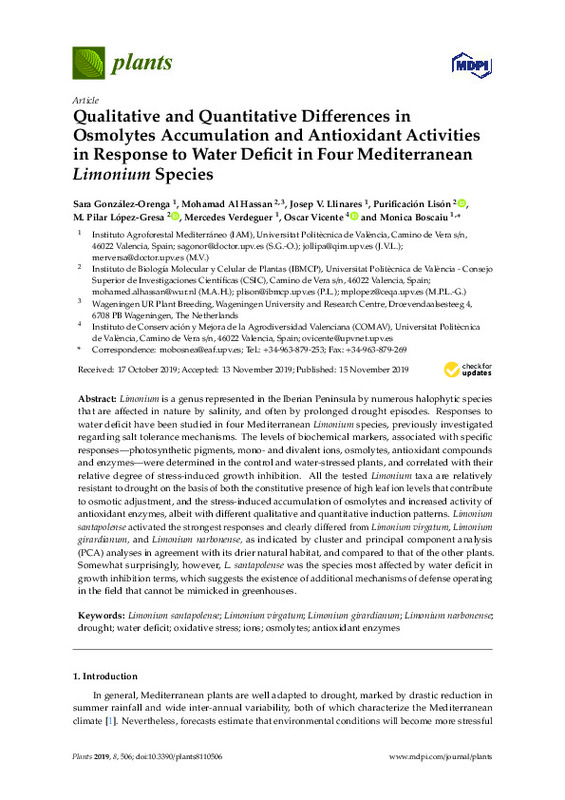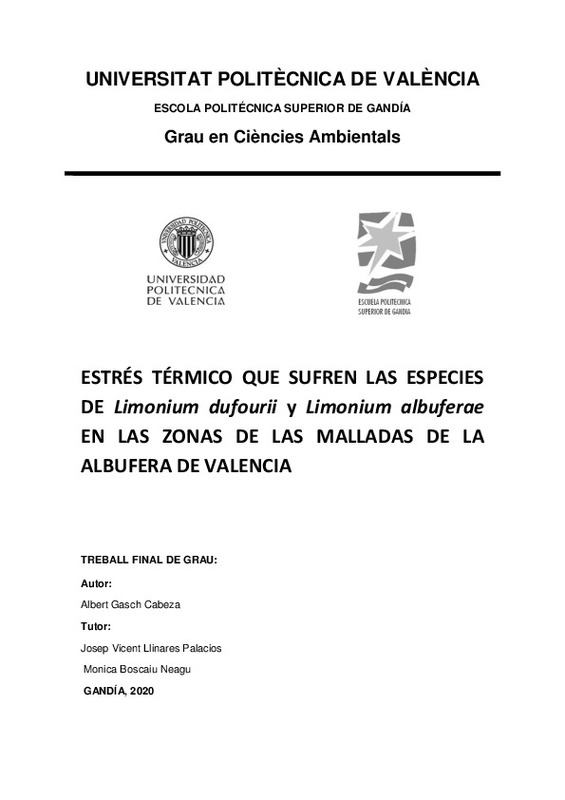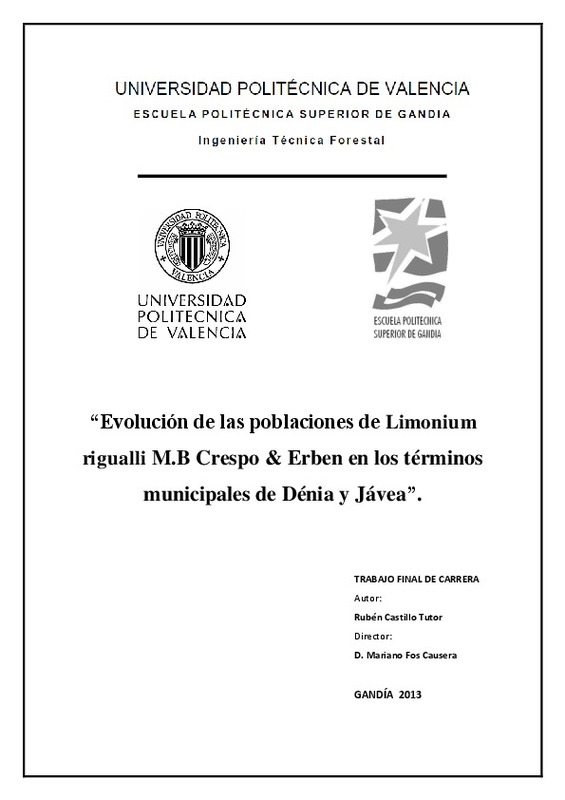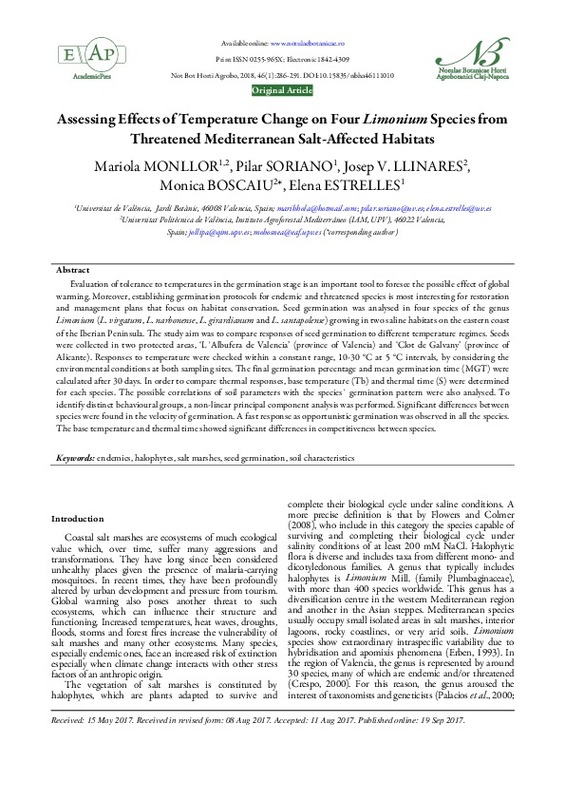Hoerling, M., Eischeid, J., Perlwitz, J., Quan, X., Zhang, T., & Pegion, P. (2012). On the Increased Frequency of Mediterranean Drought. Journal of Climate, 25(6), 2146-2161. doi:10.1175/jcli-d-11-00296.1
Munns, R. (2002). Comparative physiology of salt and water stress. Plant, Cell & Environment, 25(2), 239-250. doi:10.1046/j.0016-8025.2001.00808.x
Van Breusegem, F., & Dat, J. F. (2006). Reactive Oxygen Species in Plant Cell Death. Plant Physiology, 141(2), 384-390. doi:10.1104/pp.106.078295
[+]
Hoerling, M., Eischeid, J., Perlwitz, J., Quan, X., Zhang, T., & Pegion, P. (2012). On the Increased Frequency of Mediterranean Drought. Journal of Climate, 25(6), 2146-2161. doi:10.1175/jcli-d-11-00296.1
Munns, R. (2002). Comparative physiology of salt and water stress. Plant, Cell & Environment, 25(2), 239-250. doi:10.1046/j.0016-8025.2001.00808.x
Van Breusegem, F., & Dat, J. F. (2006). Reactive Oxygen Species in Plant Cell Death. Plant Physiology, 141(2), 384-390. doi:10.1104/pp.106.078295
Li, Z., Wakao, S., Fischer, B. B., & Niyogi, K. K. (2009). Sensing and Responding to Excess Light. Annual Review of Plant Biology, 60(1), 239-260. doi:10.1146/annurev.arplant.58.032806.103844
Shabala, S., Bose, J., Fuglsang, A. T., & Pottosin, I. (2015). On a quest for stress tolerance genes: membrane transporters in sensing and adapting to hostile soils. Journal of Experimental Botany, 67(4), 1015-1031. doi:10.1093/jxb/erv465
Schachtman, D. P., & Goodger, J. Q. D. (2008). Chemical root to shoot signaling under drought. Trends in Plant Science, 13(6), 281-287. doi:10.1016/j.tplants.2008.04.003
Fang, Y., & Xiong, L. (2014). General mechanisms of drought response and their application in drought resistance improvement in plants. Cellular and Molecular Life Sciences, 72(4), 673-689. doi:10.1007/s00018-014-1767-0
Martìnez, J. P., Ledent, J. F., Bajji, M., Kinet, J. M., & Lutts, S. (2003). Plant Growth Regulation, 41(1), 63-73. doi:10.1023/a:1027359613325
Xi, J.-J., Chen, H.-Y., Bai, W.-P., Yang, R.-C., Yang, P.-Z., Chen, R.-J., … Wang, S.-M. (2018). Sodium-Related Adaptations to Drought: New Insights From the Xerophyte Plant Zygophyllum xanthoxylum. Frontiers in Plant Science, 9. doi:10.3389/fpls.2018.01678
MILLER, G., SUZUKI, N., CIFTCI-YILMAZ, S., & MITTLER, R. (2010). Reactive oxygen species homeostasis and signalling during drought and salinity stresses. Plant, Cell & Environment, 33(4), 453-467. doi:10.1111/j.1365-3040.2009.02041.x
Sharma, P., Jha, A. B., Dubey, R. S., & Pessarakli, M. (2012). Reactive Oxygen Species, Oxidative Damage, and Antioxidative Defense Mechanism in Plants under Stressful Conditions. Journal of Botany, 2012, 1-26. doi:10.1155/2012/217037
Kar, R. K. (2011). Plant responses to water stress: Role of reactive oxygen species. Plant Signaling & Behavior, 6(11), 1741-1745. doi:10.4161/psb.6.11.17729
Golldack, D., Li, C., Mohan, H., & Probst, N. (2014). Tolerance to drought and salt stress in plants: Unraveling the signaling networks. Frontiers in Plant Science, 5. doi:10.3389/fpls.2014.00151
Gagneul, D., Aïnouche, A., Duhazé, C., Lugan, R., Larher, F. R., & Bouchereau, A. (2007). A Reassessment of the Function of the So-Called Compatible Solutes in the Halophytic Plumbaginaceae Limonium latifolium
. Plant Physiology, 144(3), 1598-1611. doi:10.1104/pp.107.099820
Al Hassan, M., Estrelles, E., Soriano, P., López-Gresa, M. P., Bellés, J. M., Boscaiu, M., & Vicente, O. (2017). Unraveling Salt Tolerance Mechanisms in Halophytes: A Comparative Study on Four Mediterranean Limonium Species with Different Geographic Distribution Patterns. Frontiers in Plant Science, 8. doi:10.3389/fpls.2017.01438
Galmés, J., Cifre, J., Medrano, H., & Flexas, J. (2005). Modulation of relative growth rate and its components by water stress in Mediterranean species with different growth forms. Oecologia, 145(1), 21-31. doi:10.1007/s00442-005-0106-4
Galmés, J., Molins, A., Flexas, J., & Conesa, M. À. (2017). Coordination between leaf CO2diffusion and Rubisco properties allows maximizing photosynthetic efficiency inLimoniumspecies. Plant, Cell & Environment, 40(10), 2081-2094. doi:10.1111/pce.13004
Guerin, G. R., Wen, H., & Lowe, A. J. (2012). Leaf morphology shift linked to climate change. Biology Letters, 8(5), 882-886. doi:10.1098/rsbl.2012.0458
Kumar, D., Al Hassan, M., Naranjo, M. A., Agrawal, V., Boscaiu, M., & Vicente, O. (2017). Effects of salinity and drought on growth, ionic relations, compatible solutes and activation of antioxidant systems in oleander (Nerium oleander L.). PLOS ONE, 12(9), e0185017. doi:10.1371/journal.pone.0185017
Marček, T., Hamow, K. Á., Végh, B., Janda, T., & Darko, E. (2019). Metabolic response to drought in six winter wheat genotypes. PLOS ONE, 14(2), e0212411. doi:10.1371/journal.pone.0212411
Silva, E. N., Ferreira-Silva, S. L., Viégas, R. A., & Silveira, J. A. G. (2010). The role of organic and inorganic solutes in the osmotic adjustment of drought-stressed Jatropha curcas plants. Environmental and Experimental Botany, 69(3), 279-285. doi:10.1016/j.envexpbot.2010.05.001
Gámez, A. L., Soba, D., Zamarreño, Á. M., García-Mina, J. M., Aranjuelo, I., & Morales, F. (2019). Effect of Water Stress during Grain Filling on Yield, Quality and Physiological Traits of Illpa and Rainbow Quinoa (Chenopodium quinoa Willd.) Cultivars. Plants, 8(6), 173. doi:10.3390/plants8060173
Van der Weijde, T., Huxley, L. M., Hawkins, S., Sembiring, E. H., Farrar, K., Dolstra, O., … Trindade, L. M. (2016). Impact of drought stress on growth and quality of miscanthus for biofuel production. GCB Bioenergy, 9(4), 770-782. doi:10.1111/gcbb.12382
Tabot, P. T., & Adams, J. B. (2014). Salt secretion, proline accumulation and increased branching confer tolerance to drought and salinity in the endemic halophyte Limonium linifolium. South African Journal of Botany, 94, 64-73. doi:10.1016/j.sajb.2014.05.009
Hanson, A. D., Rathinasabapathi, B., Chamberlin, B., & Gage, D. A. (1991). Comparative Physiological Evidence that β-Alanine Betaine and Choline-O-Sulfate Act as Compatible Osmolytes in Halophytic Limonium Species. Plant Physiology, 97(3), 1199-1205. doi:10.1104/pp.97.3.1199
Rhodes, D., & Hanson, A. D. (1993). Quaternary Ammonium and Tertiary Sulfonium Compounds in Higher Plants. Annual Review of Plant Physiology and Plant Molecular Biology, 44(1), 357-384. doi:10.1146/annurev.pp.44.060193.002041
Murakeözy, É. P., Nagy, Z., Duhazé, C., Bouchereau, A., & Tuba, Z. (2003). Seasonal changes in the levels of compatible osmolytes in three halophytic species of inland saline vegetation in Hungary. Journal of Plant Physiology, 160(4), 395-401. doi:10.1078/0176-1617-00790
GIL, R., LULL, C., BOSCAIU, M., BAUTISTA, I., LIDÓN, A., & VICENTE, O. (2011). Soluble Carbohydrates as Osmolytes in Several Halophytes from a Mediterranean Salt Marsh. Notulae Botanicae Horti Agrobotanici Cluj-Napoca, 39(2), 09. doi:10.15835/nbha3927176
Halliwell, B. (2006). Reactive Species and Antioxidants. Redox Biology Is a Fundamental Theme of Aerobic Life. Plant Physiology, 141(2), 312-322. doi:10.1104/pp.106.077073
Sofo, A., Scopa, A., Nuzzaci, M., & Vitti, A. (2015). Ascorbate Peroxidase and Catalase Activities and Their Genetic Regulation in Plants Subjected to Drought and Salinity Stresses. International Journal of Molecular Sciences, 16(12), 13561-13578. doi:10.3390/ijms160613561
Del Rio, L. A., Palma, J. M., Sandalio, L. M., Corpas, F. J., Pastori, G. M., Bueno, P., & López-Huertas, E. (1996). Peroxisomes as a source of superoxide and hydrogen peroxide in stressed plants. Biochemical Society Transactions, 24(2), 434-438. doi:10.1042/bst0240434
Kedare, S. B., & Singh, R. P. (2011). Genesis and development of DPPH method of antioxidant assay. Journal of Food Science and Technology, 48(4), 412-422. doi:10.1007/s13197-011-0251-1
Gil, R., Bautista, I., Boscaiu, M., Lidon, A., Wankhade, S., Sanchez, H., … Vicente, O. (2014). Responses of five Mediterranean halophytes to seasonal changes in environmental conditions. AoB PLANTS, 6(0), plu049-plu049. doi:10.1093/aobpla/plu049
Bose, J., Rodrigo-Moreno, A., & Shabala, S. (2013). ROS homeostasis in halophytes in the context of salinity stress tolerance. Journal of Experimental Botany, 65(5), 1241-1257. doi:10.1093/jxb/ert430
Fini, A., Brunetti, C., Di Ferdinando, M., Ferrini, F., & Tattini, M. (2011). Stress-induced flavonoid biosynthesis and the antioxidant machinery of plants. Plant Signaling & Behavior, 6(5), 709-711. doi:10.4161/psb.6.5.15069
Souid, A., Bellani, L., Magné, C., Zorrig, W., Smaoui, A., Abdelly, C., … Ben Hamed, K. (2018). Physiological and antioxidant responses of the sabkha biotope halophyte Limonium delicatulum to seasonal changes in environmental conditions. Plant Physiology and Biochemistry, 123, 180-191. doi:10.1016/j.plaphy.2017.12.008
Alscher, R. G. (2002). Role of superoxide dismutases (SODs) in controlling oxidative stress in plants. Journal of Experimental Botany, 53(372), 1331-1341. doi:10.1093/jexbot/53.372.1331
Caverzan, A., Casassola, A., & Brammer, S. P. (2016). Antioxidant responses of wheat plants under stress. Genetics and Molecular Biology, 39(1), 1-6. doi:10.1590/1678-4685-gmb-2015-0109
Gunes, A., Pilbeam, D. J., Inal, A., Bagci, E. G., & Coban, S. (2007). Influence of silicon on antioxidant mechanisms and lipid peroxidation in chickpea (Cicer arietinumL.) cultivars under drought stress. Journal of Plant Interactions, 2(2), 105-113. doi:10.1080/17429140701529399
Hameed, A., Gulzar, S., Aziz, I., Hussain, T., Gul, B., & Khan, M. A. (2015). Effects of salinity and ascorbic acid on growth, water status and antioxidant system in a perennial halophyte. AoB PLANTS, 7. doi:10.1093/aobpla/plv004
LICHTENTHALER, H. K., & WELLBURN, A. R. (1983). Determinations of total carotenoids and chlorophylls a and b of leaf extracts in different solvents. Biochemical Society Transactions, 11(5), 591-592. doi:10.1042/bst0110591
Weimberg, R. (1987). Solute adjustments in leaves of two species of wheat at two different stages of growth in response to salinity. Physiologia Plantarum, 70(3), 381-388. doi:10.1111/j.1399-3054.1987.tb02832.x
Bates, L. S., Waldren, R. P., & Teare, I. D. (1973). Rapid determination of free proline for water-stress studies. Plant and Soil, 39(1), 205-207. doi:10.1007/bf00018060
Grieve, C. M., & Grattan, S. R. (1983). Rapid assay for determination of water soluble quaternary ammonium compounds. Plant and Soil, 70(2), 303-307. doi:10.1007/bf02374789
Nawaz, K., & Ashraf, M. (2010). Exogenous Application of Glycinebetaine Modulates Activities of Antioxidants in Maize Plants Subjected to Salt Stress. Journal of Agronomy and Crop Science, 196(1), 28-37. doi:10.1111/j.1439-037x.2009.00385.x
DuBois, M., Gilles, K. A., Hamilton, J. K., Rebers, P. A., & Smith, F. (1956). Colorimetric Method for Determination of Sugars and Related Substances. Analytical Chemistry, 28(3), 350-356. doi:10.1021/ac60111a017
Al Hassan, M., Chaura, J., López-Gresa, M. P., Borsai, O., Daniso, E., Donat-Torres, M. P., … Boscaiu, M. (2016). Native-Invasive Plants vs. Halophytes in Mediterranean Salt Marshes: Stress Tolerance Mechanisms in Two Related Species. Frontiers in Plant Science, 7. doi:10.3389/fpls.2016.00473
Hodges, D. M., DeLong, J. M., Forney, C. F., & Prange, R. K. (1999). Improving the thiobarbituric acid-reactive-substances assay for estimating lipid peroxidation in plant tissues containing anthocyanin and other interfering compounds. Planta, 207(4), 604-611. doi:10.1007/s004250050524
Taulavuori, E., Hellström, E., Taulavuori, K., & Laine, K. (2001). Comparison of two methods used to analyse lipid peroxidation from Vaccinium myrtillus (L.) during snow removal, reacclimation and cold acclimation. Journal of Experimental Botany, 52(365), 2375-2380. doi:10.1093/jexbot/52.365.2375
Loreto, F., & Velikova, V. (2001). Isoprene Produced by Leaves Protects the Photosynthetic Apparatus against Ozone Damage, Quenches Ozone Products, and Reduces Lipid Peroxidation of Cellular Membranes. Plant Physiology, 127(4), 1781-1787. doi:10.1104/pp.010497
Blainski, A., Lopes, G., & de Mello, J. (2013). Application and Analysis of the Folin Ciocalteu Method for the Determination of the Total Phenolic Content from Limonium Brasiliense L. Molecules, 18(6), 6852-6865. doi:10.3390/molecules18066852
Zhishen, J., Mengcheng, T., & Jianming, W. (1999). The determination of flavonoid contents in mulberry and their scavenging effects on superoxide radicals. Food Chemistry, 64(4), 555-559. doi:10.1016/s0308-8146(98)00102-2
Bradford, M. M. (1976). A rapid and sensitive method for the quantitation of microgram quantities of protein utilizing the principle of protein-dye binding. Analytical Biochemistry, 72(1-2), 248-254. doi:10.1016/0003-2697(76)90527-3
Beyer, W. F., & Fridovich, I. (1987). Assaying for superoxide dismutase activity: Some large consequences of minor changes in conditions. Analytical Biochemistry, 161(2), 559-566. doi:10.1016/0003-2697(87)90489-1
Aebi, H. (1984). [13] Catalase in vitro. Oxygen Radicals in Biological Systems, 121-126. doi:10.1016/s0076-6879(84)05016-3
Connell, J. P., & Mullet, J. E. (1986). Pea Chloroplast Glutathione Reductase: Purification and Characterization. Plant Physiology, 82(2), 351-356. doi:10.1104/pp.82.2.351
[-]












